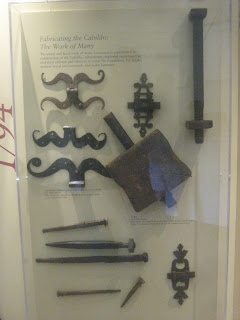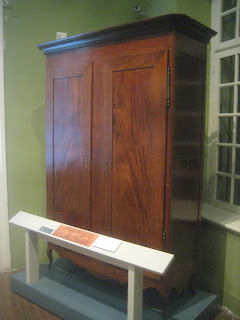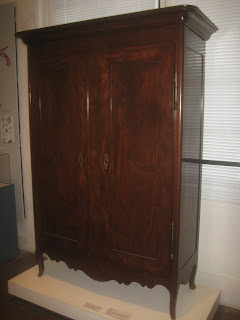The Cabildo was the seat of colonial government in New Orleans, Louisiana, and
is now a museum. The Cabildo is located along Jackson Square, adjacent to St.
Louis Cathedral. The Cabildo was rebuilt between 1795-99 as the home of the
Spanish municipal government in New Orleans, and the mansard roof was later
added in the 1840's, in French style. The building took its name from the
governing body who met there — the "Illustrious Cabildo," or city council. The
Cabildo was the site of the Louisiana Purchase transfer ceremonies in 1803, and
continued to be used by the New Orleans city council until the mid 1850s.
In 1895 it was in a state of decay and proposed for demolition; artist
William Woodward led a successful campaign to have the historic building
preserved and restored.
In 1911 the Cabildo became the home of the Louisiana
State Museum. The museum displays exhibits about the history of Louisiana from
its settlement up through the Reconstruction era, and the heritage of the ethnic
groups that live there.
Some of the original 18th century wrought iron hardware used in the
Cabildo.
The Cabildo's second floor gallery has original 1790's Neoclassical
architectural details
The Cabildo's second floor gallery has original 1790's Neoclassical
architectural details
When the Marquis de Lafayette visited the Crescent City in 1825, the city
allowed him the use of the Sala Capitular as his residence and the main
staircase was renovated for him.
A view from the Cabildo's second floor gallery
A view from the Cabildo's second floor gallery
The Cabildo's second floor gallery provides a great view of Jackson
Square.
The Cabildo still has some original painted cypress wrap-around Creole
mantels on the second floor
The Cabildo still has some original painted cypress wrap-around Creole
mantels on the second floor
American Indians
The First Families of Louisiana on the Eve of French
Settlement
At the time of French settlement in 1700, many Indian groups lived in
Louisiana, which then encompassed the Mississippi Valley and Gulf Coast region.
These groups ranged from small clans of hunters to large communities of farmers.
Several Louisiana societies established extensive cultural and economic exchange
networks and traded material goods, belief systems, language patterns,
technology, and recreational practices with other native groups in North America
and probably even in Mexico, Central America, and the Caribbean, and later with
European settlers.
Societies
As in most Indian societies, Louisiana Indians carried out
tasks defined along gender lines. Men ruled and defended the tribal communities
and hunted and constructed buildings and canoes with tools they made. Women
cared for children and the elderly, planted crops, and made clothes and
utensils, which they used to prepare foods and decorate their homes and
religious centers. One early French settler, Antoine Simon Le Page du Pratz,
observed that "most of the labour and fatigue falls to the share of the women,"
while Indian men had "a great deal of more spare time than the women."
Hunting was economically pivotal as a source of food, clothing, tools and
jewelry. Indians stalked deer, bear, bison and a multitude of smaller game
animals. When Europeans came to Louisiana, they noted that the Natchez in
particular practiced the "communal surround." Upon sighting a deer, about a
hundred men formed an open crescent. They drove the deer from side to side until
it dropped to the ground
The Iberville Stone
1699
The "Iberville Stone" was recovered from the site of Fort Maurepas, the first permanent settlement established by Iberville in the Mississippi Valley.
The "Iberville Stone" was recovered from the site of Fort Maurepas, the first permanent settlement established by Iberville in the Mississippi Valley.
Colonial Louisiana
The promise of prosperity brought people to Louisiana, voluntarily or by
force. Among the many ethnic groups in colonial Louisiana were people of French,
Canadian, Spanish, Latin American, Anglo, German, and African descent. No one of
these cultures dominated in the eighteenth century, and along with Native
Americans, they provided the initial ingredients for Louisiana's famous "gumbo"
of cultures.
Spaniards were the first to venture into the Mississippi River region.
Hernando de Soto's overland expedition in 1542 was the first to confirm European
discovery of the mighty river, but the hostile climate, wildlife, and geography
convinced Spain to look elsewhere for precious metals and fertile soils.
Louisiana was ignored for nearly a century and a half, until France's King Louis
XIV, the "Sun King," began encouraging exploration of the Mississippi River in
order to enlarge his own empire and halt Britain's and Spain's expansion. In
1682, René-Robert Cavelier, Sieur de La Salle, reached the river's mouth and
proclaimed possession of the river and all the lands drained by it for France,
naming this vast expanse "Louisiane," or "Louis' land."
Phillipe de Marigny, father of Bernard Marigny, founder of the town of
Mandeville.
Phillipe de Marigny, father of Bernard Marigny, founder of the town of
Mandeville.
1822 portrait of Father Anthony Sedella, “Pere Antoine,” who was pastor of
St. Louis Cathedral for many years
Jean-Baptiste Le Moyne, Sieur de Bienville
Rudolph Bohunek
1933
A native of Montreal, Canada, and considered the "Father of Louisiana," Bienville dominated the colony's political scene for decades, serving as colonial commandant or governor of Louisiana from 1701 until 1713, 1716-17, 1718-25, and 1733-43.
1933
A native of Montreal, Canada, and considered the "Father of Louisiana," Bienville dominated the colony's political scene for decades, serving as colonial commandant or governor of Louisiana from 1701 until 1713, 1716-17, 1718-25, and 1733-43.
While a French colony, Louisiana was governed alternately by the crown and
by several chartered proprietors, who contracted with the crown for
administration of the colony and a trade monopoly in exchange for settlers and
slaves to supply the colony with goods. Antoine Crozat was Louisiana's first
proprietor of Louisiana from 1712 until 1717, when he resigned and the crown
turned the colony over to John Law, who created the corporation called the
Company of the Indies in 1719 to govern Louisiana. Beset by failed crops, Indian
wars, slave insurrections, and financial disaster, the Company of the Indies
returned the colony back to the crown of France, who administered it until 1763,
when it turned Louisiana over to Spain.
Armoire
Celestin Glapion
c. 1790
Glapion was a free man of color and furniture-maker in colonial New Orleans.
c. 1790
Glapion was a free man of color and furniture-maker in colonial New Orleans.
Armoire
Celestin Glapion
c. 1790
Glapion was a free man of color and furniture-maker in colonial New Orleans.
c. 1790
Glapion was a free man of color and furniture-maker in colonial New Orleans.
Although most settlers in Louisiana were of the Catholic faith, a few were
Protestants or Sephardic Jews. Royal policy in France and Spain prohibited
non-Catholics from living in the colonies, but especially in frontier regions
like Louisiana, enforcement was scarce. At times Protestants were even
encouraged to settle in Louisiana.
Early Louisiana's most active churchgoers were African Americans. Although
in 1800 about an equal number of blacks and whites lived in New Orleans, twice
as many blacks were baptized in St. Louis Cathedral, the main church in colonial
Louisiana, which still stands on Jackson Square in New Orleans, next to the
Cabildo. Many Africans and creoles (American-born) continued to practice their
African religious rituals covertly or merged them with Catholic beliefs.
All trade conducted with the colony was supposed to take place with the
mother country, thereby keeping profits within the imperial system. This
practice did not work well in Louisiana at first, however, because Louisiana had
too few desirable products to export and too few people to exploit what natural
resources existed. Toward the end of the colonial period, an export-directed
economy finally succeeded for Louisiana, and the colony benefited from the
exportation of such crops as cotton, sugar, tobacco, indigo, and rice and from
natural resources, like timber, furs, hides, and fish.
Louisianians used earnings from the export of cash crops and natural
resources to purchase imported slaves and merchandise, primarily manufactured
goods and foods they did not produce themselves, such as textiles, furniture,
and household furnishings. For most of the colonial period wholesale merchants
imported goods and slaves first from France and later from Spain. Smuggling
goods from European and American ships became prevalent and remained so, even
when trade restrictions in the colony were lifted.
New Orleans quickly became the hub of a new regional trade network, with
goods flowing into the city along the surrounding waterways to be sold in the
many shops and market stalls throughout the city. Louisianians also began to
manufacture goods and provide services that could not legally or even illegally
be obtained from other countries and colonies. During this period, most
manufacturing involved the processing of crops and natural resources and the
production of articles needed in the home: furniture, leather goods, clothing,
utensils, and iron implements. In 1795 about half of New Orleans carpenters,
joiners, shoemakers, silversmiths, gunsmiths, and seamstresses were free blacks.

























































No comments:
Post a Comment